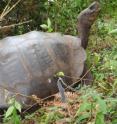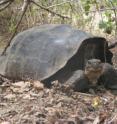Tortoise species thought to be extinct still lives, genetic analysis reveals
Dozens of giant tortoises of a species believed extinct for 150 years may still be living at a remote location in the Galápagos Islands, a genetic analysis conducted by Yale University researchers reveals. The analysis, published Jan. 9 in the journal Current Biology, suggests that direct descendants of at least 38 purebred individuals of Chelonoidis elephantopus live on the volcanic slopes of the northern shore of Isabela Island -- 200 miles from their ancestral home of Floreana Island, where they disappeared after being hunted by whalers.
"This is not just an academic exercise," said Gisella Caccone, senior research scientist in the Department of Ecology and Evolutionary Biology and senior author of the paper. "If we can find these individuals, we can restore them to their island of origin. This is important as these animals are keystone species playing a crucial role in maintaining the ecological integrity of the island communities."
On his historic voyage to the Galapagos in 1835, Charles Darwin observed that the shells of tortoises living on different islands of the chain had different shapes -- one of the observations that inspired his theory of natural selection. For instance, the shells of C. elephantopus on Floreana were saddle-shaped while tortoises on other islands had domed-shaped shells.
On Floreana, however, the tortoises disappeared because of hunting by whalers and workers at a heating oil factory that had been established on the island.
A team of Yale researchers visiting Volcano Wolf on the northern tip of Isabela Island in 2008 took blood samples from more than 1600 tortoises and compared them to a genetic database of living and extinct tortoise species. An analysis detected the genetic signatures of C. elephantopus in 84 Volcano Wolf tortoises, meaning one of their parents was a purebred member of the missing species. In 30 cases breeding had taken place within the last 15 years. Since the lifespan of tortoises can exceed 100 years, there is a high probability that many purebreds are still alive, note the researchers.
"To our knowledge, this is the first report of the rediscovery of a species by way of tracking the genetic footprints left in the genomes of its hybrid offspring," said former Yale postdoctoral researcher Ryan Garrick, now assistant professor at the University of Mississipi and first author of the paper.
Intensive breeding of hybrids might allow scientists to resuscitate the C. elephantopus species even if sufficient numbers of purebred tortoises can not be found, Garrick said.
The team doubts that the tortoises reached Volcano Wolf on their own and theorized the tortoises were transported as food from Floreana, but were either thrown overboard by whalers or left on shore of Isabela.
Source: Yale University
Other sources
- 'Extinct' Galapagos tortoises may be alivefrom UPI13 years ago
- 'Extinct' Galapagos tortoises may be alivefrom UPI13 years ago
- 'Extinct' tortoise likely still exists, scientists sayfrom CBC: Technology & Science13 years ago
- No longer extinct? Traces of giant tortoises foundfrom CBSNews - Science13 years ago
- 'Extinct' giant tortoise found on remote islandfrom MSNBC: Science13 years ago
- 'Extinct' Galapagos Tortoise Reappearsfrom Live Science13 years ago
- Extinct tortoise may still existfrom BBC News: Science & Nature13 years ago
- Genetic analysis shows tortoise species thought to be extinct for 150 years still livesfrom Physorg13 years ago



